This is part 2 of a series of 3 articles looking at design considerations for our Cold Climate Permaculture site using the Keyline Scale of Permanence as a organizing framework, as well as an informative read for anyone interested.

The aesthetic curves of the Keyline layout at ridgedale PERMACULTURE
The previous article introduced some basic Keyline concepts and looked at the Site Specifics and how the Landform will influence the patterning of our farmscape. This article looks at our considerations for water and access.
P.A.Yeoman’s Scale of Permanence (SoP)
- Climate
- Landform
- Water
- Roads
- Trees
- Buildings
- Subdivisions
- Soil
Water for Life
Water is where we begin with design; as it is the greatest limiting factor for production, and its movement in the landscape depends entirely on the landform. Earthen constructs such as ponds, dams, swales, etc, are very permanent features in a landscape. Roads are too, and the well constructed roads and earthworks of ancient cultures can still be found functioning today, from the Romans to the Kogi.
From a design perspective, water has many duties. It is what makes all life possible and in a farm perspective this may mean irrigation storage, drinking water and water stored in living soil. It provides rich and diverse production habitat and aquatic ecosystems cannot be underestimated in their importance in farmscapes. Robust and well designed water systems can add significant return-on-investment regarding property value.
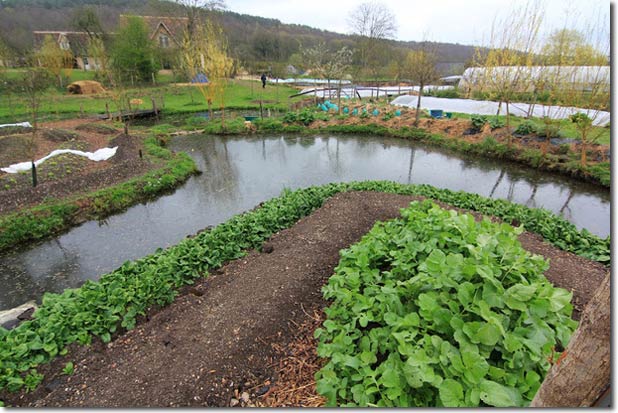
Water in the landscape performs multiple functions & gives aesthetic charm
We can also possibly produce energy by micro-hydro, water wheels, etc., as well as provide for human aesthetic needs.
The principle of designing water into Permaculture systems involve taking water over the longest path, over the most time, moving as slowly as possible with the most passive friction, affecting as many living things as possible. This is a fertile situation.
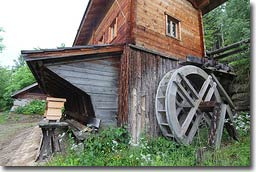 Here in Sweden, where we have snow melt in the spring, many landowners put a lot of resources into draining water off their land, as discussed in the previous article. Can you have too much water? It is possible in the very short term, but as a system this is somewhat doubtful. How to rapidly build soil and make use of the water is a good directive. Under utilized rainfall is the primary reason that desertification is spreading across the larger half of the land surface of the planet today. Agriculture is the largest consumer of water, and in many parts of the world this is derived from mega-dam projects. Mega-dams have displaced over 80 million people in the last 100 years, and the methane released from stagnating nutrient flows make large dams more atmospherically polluting than coal fired power stations (Methane is 22x more potent as a greenhouse gas than CO2). Here in Sweden we do not have the problems of the brittle landscapes, but I see few farmscapes that are future-proof regarding water. Pumps and other degenerative technologies are costly and need constant maintenance, so any chance to use gravity fed systems is high up on the design agenda.
Here in Sweden, where we have snow melt in the spring, many landowners put a lot of resources into draining water off their land, as discussed in the previous article. Can you have too much water? It is possible in the very short term, but as a system this is somewhat doubtful. How to rapidly build soil and make use of the water is a good directive. Under utilized rainfall is the primary reason that desertification is spreading across the larger half of the land surface of the planet today. Agriculture is the largest consumer of water, and in many parts of the world this is derived from mega-dam projects. Mega-dams have displaced over 80 million people in the last 100 years, and the methane released from stagnating nutrient flows make large dams more atmospherically polluting than coal fired power stations (Methane is 22x more potent as a greenhouse gas than CO2). Here in Sweden we do not have the problems of the brittle landscapes, but I see few farmscapes that are future-proof regarding water. Pumps and other degenerative technologies are costly and need constant maintenance, so any chance to use gravity fed systems is high up on the design agenda.
We will deal with water at the farm resiliently, via soil development, including Keyline subsoiling and ripping, managing our grazing holistically, perennial strip plantings, ponds, dams, intelligent farm track positioning and appropriate technology.
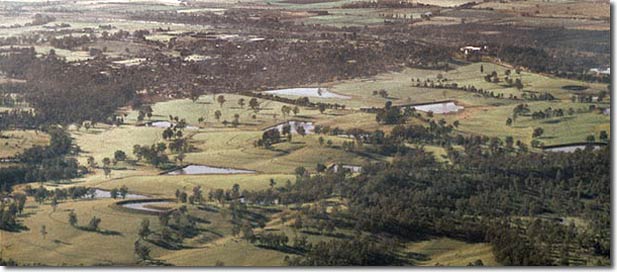
P.A. Yeoman’s ‘Yobarnie’ — originally storing 715 mega liters in various types of earthen dams
in eastern Australia with sparse rainfall. Photo courtesy David Holmgren.
If farms (and urban areas?!) would switch to small scale water harvesting and farmer / community controlled water storage based on Keyline patterning there would be an end to flash floods, much less oil needed to pump water around, an increase in community resiliency, better care for watersheds and it would actually be cheaper with more environmentally sound habitats.
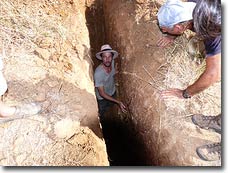 Earthworks
Earthworks
Earthworks are usually significant investments with potential risks and like all good design, it is worth holistically considering different ways of obtaining any objective thoroughly. Creating earthen dams and swales deals with the Landform layer of the Scale of Permanence. These are constructs that should be there in hundreds (if not thousands) of years time if built well. This is a very different disturbance and strategy than something like subsoiling, which deals with the Soil layer of the SoP.
Soil is by far the cheapest and most effective place to conserve water, with more layers of stacked benefits than any other way you could store it. One particle of humus can hold on average four parts of water, and so we start to see the cost effective, production-increasing effects of building healthy soils — the basis of all our production, and indeed, of civilization itself. For every percentage increase in soil carbon we increase the soil water holding capacity by 144 000l per Ha.
For the sake of design consideration in this article I will share this; I have seen swales implemented in various countries where I personally think they are totally inappropriate and unnecessary. It strikes me that trends in popular Permaculture risk diverging from design planning and holistic decision-making. For example, when I consider the cost of subsoiling (which allows water to slow, sink and possibly spread), combined with good grazing (which can rapidly develop deeper living soil that can hold the water) I have seen quite a few earthwork examples where I’m positive I could achieve the same outcomes with radically lower cost, with water in the soil where it is actually needed for production with no major risks. Holistic Management decision making is incredibly useful in the design process when weighing up which technology / strategies, etc, will lead you optimally towards the holistic goals and resource base you are managing for.
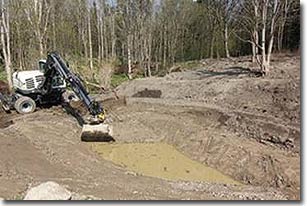 Constructing dams and ponds is a big subject and depends on so many variables, both human and geophysical. Due diligence is vital in order not to risk breaking the bank/ limbs/ laws. There are some brief notes of some considerations at the end of thisarticle I wrote after a Dryland training last year. Important considerations for designing these systems include:
Constructing dams and ponds is a big subject and depends on so many variables, both human and geophysical. Due diligence is vital in order not to risk breaking the bank/ limbs/ laws. There are some brief notes of some considerations at the end of thisarticle I wrote after a Dryland training last year. Important considerations for designing these systems include:
- Annual rainfall
- Rainfall distribution
- Water needs
- Maximum perceived rainfall events
- Catchments / Watershed analysis
- Roof catchments
- Soil Characteristics
- Soil infiltration rates
- Geophysical analysis
- Costing analysis
Because of our climate and water needs, and the fact we have flowing streams with a height difference (allowing us to run a RAM pump) our ponds and dams are mainly for simple aquaculture — for farm use, recreation and habitat. They are not particularly cost effective in this regard, ie, we don’t need the water, but we want it. Having friends with old machinery can be a big help as in this case investing a lot of money in this work would perhaps not be a great financial decision for the farm. On another hand well-designed earthworks will add value to a property, so could be viewed as a longer term investment with a lot of great benefits. If soil resources do not allow earthen dam construction one good alternative is Geo-synthetic Clay Liners (GCL), which is a layer of bentonite clay, sandwiched between textiles that swells with water contact. It is necessary to cover this with topsoil, which, incidentally, allows immediate planting and rapid repair from the disturbance. GCL works out at about 8 Eur/ m2 here, which is great. It self seals around overspill pipes and roots, which makes it very pleasing to work with.
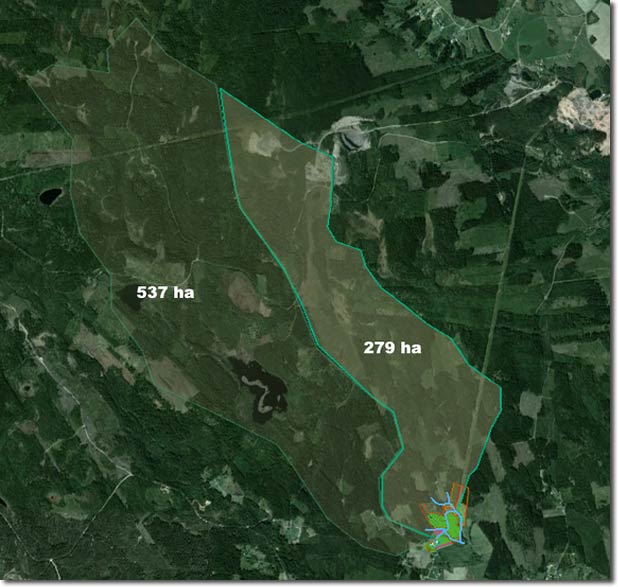
Catchment area that supplies the 2 streams at ridgedale
The two streams that flow through the property have large secure catchments, mostly forest with few properties — 1800 M/L land in the sub watershed, marked 279ha, and around 3500 M/L in the larger sub watershed. That’s a bunch of water, and we can utilize the height drop across our farm to meet our water needs at minimal cost using a RAM pump (see below).
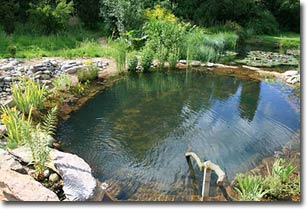 An example of functionality & beauty, the Nelson’s natural swimming pool |
Natural Swimming Pools
Leisure, aesthetics and health are vital aspects of regenerative design. The addition of features like this in an overall site development cannot fail to increase the property value too. Who wouldn’t want chlorine-free swimming?
Our roof catchments will collect, firstly, into ferro cement tanking to ensure a good quality pump- free drinking water supply, and then overspill into water bodies. Planning overflows from each water body is crucial! Understanding levels and calculating for extreme weather possibilities is in order. Natural swimming pools are an awesome integration into a home setting water system, and could double up in water cleaning and production systems as well as all the other benefits ponds bring to an ecosystem. To have a good swimming lane it pays to make a conventional shaped cut and the whole thing is created with a cleverly folded liner. The shallow edges are planted with sub marginal aquatic species amongst gravel or similar medium to make an attractive and clean finish. A simple suspended and submerged rope marks the edges for swimmers. A solar powered skimmer can keep the surface clear of leaves, etc. The main cost is digging and a liner if it’s needed.
Ferro Cement Tanks
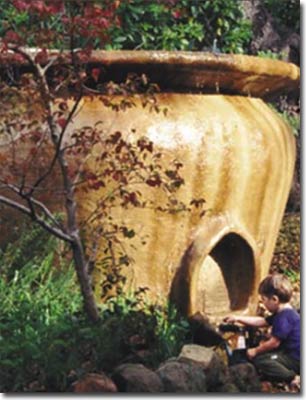 Photo courtesy Oasis Design Photo courtesy Oasis Design
|
Ferro-cement tanking is usually much cheaper than brick or straight concrete, using far less material to make a strong frame for water tanks of more than 1000L. Plastic and tin sheet tanking is also an option, and all have their pros and cons. Part of the beauty of a ferro-cement tank is you can make it a feature rather than an eye-sore, which feels important for the placement of our tanks, in the farm center.
There are different methods of constructing ferro-cement water tanks, but the usual ratio of cement to dry sand is 1:3 by volume. The ratio of water to cement has an important effect on the final strength of the mortar. A ratio of about 0.4:1 to 0.5:1 (ratio of water:cement by weight) is ideal, which is equivalent to between 20 to 25 litres of water to each 50kg bag of cement. When we have built tanks in hotter climates / weather, we have used wet blankets to slow the curing process. Plastic wrapping could be used too.
Building tanks without using formwork
This method requires a stiff wire frame around which flexible mesh such as ‘chicken wire’ is wrapped. The first layer of mortar is applied by a mason working on one side of the tank, with an assistant on the other side holding a plastering float in the right place to allow the mortar to be compacted without it falling through the mesh.
Building tanks using temporary formwork
Temporary formwork, made of wood, flat or corrugated sheets of steel, or coiled pipe is placed against one face of the tank during the application of the initial layers of mortar. The formwork is removed before plastering the inside of the tank.
Building tanks using permanent formwork
Formwork, such as corrugated sheets, may be left in place permanently, plastered on both the inside and the outside.
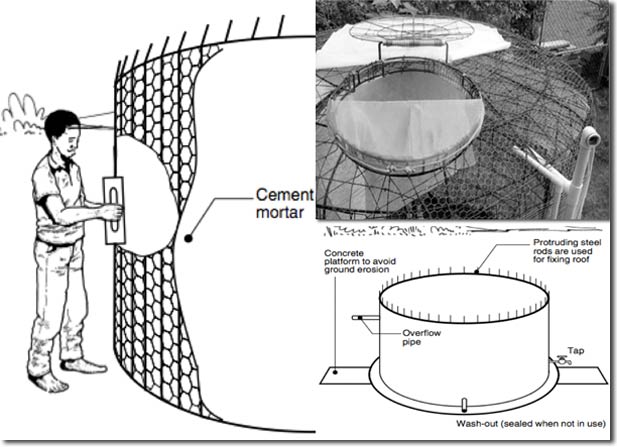
Photo: Loughborough University
For cold climate use, this kind of tanking could be used as integrated rainwater harvesting / heat sink in the back of a greenhouse, or placed underground to prevent freezing. Buried below frost level a simple old- fashioned hand pump can serve to provide drinking water year round. We will use ours for rainwater collection for drinking as well as other tanks for irrigation of kitchen gardens and animals via roof collection and RAM pump supply. These tanks will need draining when winter comes on. (It is worth noting that flowing water takes much longer to freeze — see RAM pump video below.)
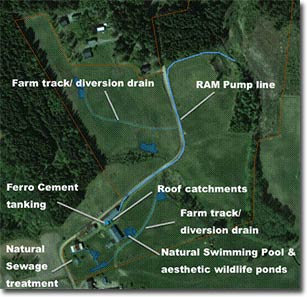 Water lines, rainwater harvest & diversion drains in our water network |
Tracks & Access
As mentioned in the previous article, we do not have convenient higher storage sites for earthen dams for irrigation of perennial crops or livestock. However, we have surface flow from springs in the NW paddock that can be developed, and marginal areas that make suitable dam sites. These areas will be suitable for recreation, a small amount of aquatic production for farm needs and in places acting as heat sinks and reflective surfaces (particularly important for leveraging the microclimate in the kitchen gardens for example). We also have a lot of large rocks (extracted from the field by hand long ago) that will be semi-submerged in the water’s edge to help heat the water too. Having microclimates within the water bodies, eg shallow and deep water, allows more ‘stacking’ of life within it. Any overspills with height drop (such as in our North paddock) can be conveniently spilled down rocky falls to eliminate erosion and oxygenate the water in the process.
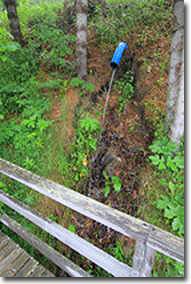 The farm tracks are needed for access and harvesting, but serve the double function as diversion drains, leading overspill from one water body / roof catchment to the next — a good example of the Permaculture directive “every element performs many functions.” In designing water it is important to plan for maximum possible flow rates and a check around old weather records and trends can help ensure the systems are robust and capable of dealing with any episodic rainfall events. An ideal road or track grading drop of 1:200 to 1:400 will keep water moving slowly — easy to survey with simple tools like a bunyip level or rotating lazer level. A ditch (ideally on the ‘inside’ of the road) harvests the water slowly and under control. The size will be calculated according to maximum presumed flow rates. Roads should ideally be placed slightly off-contour for this purpose, or on top of ridges where water can shed easily off either side. At ridgedale we will construct these graded tracks with the same machine that creates our ponds and dams. Graders and bulldozers are also used.
The farm tracks are needed for access and harvesting, but serve the double function as diversion drains, leading overspill from one water body / roof catchment to the next — a good example of the Permaculture directive “every element performs many functions.” In designing water it is important to plan for maximum possible flow rates and a check around old weather records and trends can help ensure the systems are robust and capable of dealing with any episodic rainfall events. An ideal road or track grading drop of 1:200 to 1:400 will keep water moving slowly — easy to survey with simple tools like a bunyip level or rotating lazer level. A ditch (ideally on the ‘inside’ of the road) harvests the water slowly and under control. The size will be calculated according to maximum presumed flow rates. Roads should ideally be placed slightly off-contour for this purpose, or on top of ridges where water can shed easily off either side. At ridgedale we will construct these graded tracks with the same machine that creates our ponds and dams. Graders and bulldozers are also used.
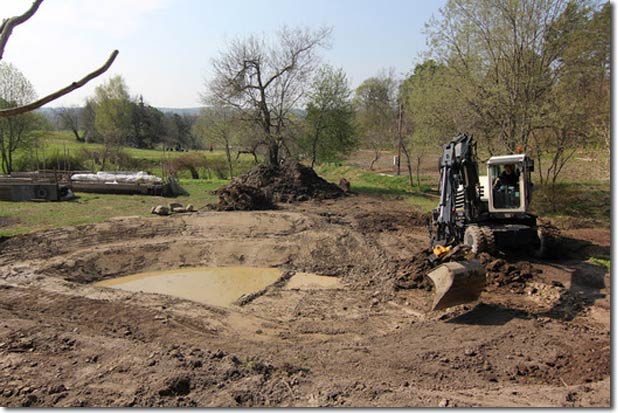
Most excavators in Sweden have Rototilt® ankles allowing highly tactile earth sculpture
Badly constructed roads are incredibly expensive to maintain, and another good example of how useful the SoP is for organizing the patterning of landscapes with a much longer-term holistic overview in mind. P.A. Yeoman’s wrote The City Forest (1971) describing how whole towns / cities could be planned very efficiently with this process. It’s well worth a read.
RAM Pumps
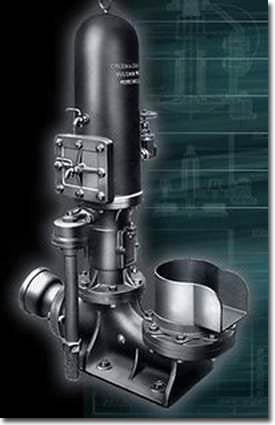 G&C – leaders in this awesome tech |
We have a 67m fall across our land, and the benefit of two perennial streams means we can use this amazingly simple technology to pump fresh and constantly flowing water around our farm. Green & Carter in the UK have been making RAM pumps for over 200 years and still only make this single product, which they guarantee “forever”. They have pumps still in operation from the 1800s. They aren’t cheap, considering you can make your own for 150 euros, but in my mind some things are worth investing in. They will certainly out-perform a home made version, plus in today’s world I’d consider buying anything with a lifetime guarantee.
One of the beautiful aspects of this set up is that we can run a 25mm pipe along our fencing to the barn, with quick access outlets (and taps on the ‘downstream’ side) every 15–20m. This means with 100m of 25mm hose on a trolley reel we can connect up and have running fresh water supplied anywhere on the farm, with no electricity or oil needed. This will suit our mobile grazing set up, as well as give us security for the large number of perennial tree and shrub crops we are establishing on the Keyline layout. Simple and effective.
Conventionally it takes a lot of power to pump water around piping, and pipes are best laid along or slightly off contour along the centers of ridges. Laying pipe by access / fencing makes everything functional, accessible and just plain sensible. If we wanted to bury the pipe we could adapt the Keyline plow to do this, but we are keeping it exposed for simplicity and adaptability — conveniently the lowest point in the whole line is right above the creek, so with a simple valve we can drain the whole system.
The pump can be run into each side of winter and can supply drinking troughs well past the time they conventionally freeze. As long as the pump keeps running, it’s fine. If it stops the pipes will burst! Here’s a nice example of a RAM pump in winter action in -10c:
On its normal circuit the rammed water will keep ferro-cement tanking full, then overspill into the swimming pool system, through connected pools and back down the diversion drain on its journey back to the creek. This cycling of water through pond systems offers increased oxygen levels too. It is worth noting you can also get compound type RAMs that allow you to use the stream flow (‘dirty’) to pump up a separate supply of water, eg, well water (‘clean’) for household consumption.
In the next section we’ll look at the planting patterns, species choices and ground preparations for our diverse perennial cropping as well as consider buildings — retrofitting and adapting for resiliency….
Originally published here.


